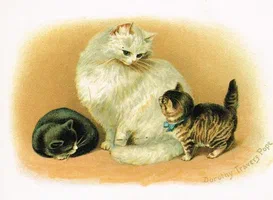Researchers from the Texas A&M School of Veterinary Medicine & Biomedical Sciences (VMBS) and a team of interdisciplinary collaborators have made groundbreaking findings about the evolution of cats, shedding light on the different genetic changes that differentiate cat species and contribute to their survival abilities, such as their ability to smell prey.
The study, recently published in Nature Genetics, involved comparing the genomes of several cat species. The research revealed why cat genomes tend to have fewer complex genetic variations compared to other mammal groups, like primates. Additionally, the study provided new insights into the regions of cat DNA that are most likely to evolve rapidly and play a significant role in species differentiation.
Dr. Bill Murphy, a professor of veterinary integrative biosciences at VMBS and an expert in cat evolution, explained that the goal of the study was to better understand the genetic basis of the trait differences between cat species. By utilizing advanced genomic mapping technologies, the researchers aimed to gain a more comprehensive understanding of cat evolution.
The findings of this study have significant implications for various fields of study, including feline diseases, behavior, and conservation. With a better understanding of the genetic differences that make each type of cat unique, researchers can now delve deeper into studying and addressing various aspects related to cats.
One interesting discovery made by the scientists is the stability of feline chromosomes compared to other mammal groups. While great apes and humans have a higher tendency for genetic variation, such as duplications and rearrangements in their chromosomes, cats have far fewer of these variations. This difference in genetic stability between cats and apes may contribute to their respective evolutionary paths.
One key factor that contributes to the variation between cats and apes is the frequency of segmental duplications, which are highly similar copies of DNA segments found within the genome. Primate researchers have connected these duplications to chromosome rearrangements. The study revealed that cats have only a fraction of the segmental duplications found in other mammal groups, such as primates.
However, despite having fewer large genetic rearrangements in their DNA, cats still possess numerous differences. Through the research, Murphy and his team gained a better understanding of which parts of the cat DNA contribute to these variations, especially those that define species differentiation.
The researchers discovered that a specific repetitive element called DXZ4, located in the center of the X chromosome, is responsible for genetic isolation between at least two cat species—the domestic and jungle cats. While DXZ4 does not code for physical traits like fur color, it plays a crucial role in the three-dimensional structure of the X chromosome and likely influences cat speciation.
As the researchers compared the genomes of different cat species, they found that DXZ4 evolved at a faster rate than 99.5% of the rest of the genome. This rapid evolution likely contributes to cat speciation.
Furthermore, the study uncovered the links between the number of olfactory genes, which are responsible for scent detection in cats, and the variations in their social behavior and adaptation to their surroundings. Cats heavily rely on their sense of smell for hunting and survival, so understanding the genetic variation in olfactory genes is crucial.
The researchers found significant differences in certain odorant genes between lions and tigers. Lions, being social animals, have fewer odorant genes involved in detecting pheromones, as they constantly interact with other lions. In contrast, tigers, which live solitary lifestyles and cover large territories, possess a larger repertoire of olfactory and pheromone receptors.
Domestic cats, having close proximity to humans and less need to travel for resources, have lost a wide range of olfactory genes over time. However, the researchers also found specific olfactory genes in fishing cats, a wild cat species adapted to an aquatic lifestyle, which are not present in other cat species. This discovery suggests that fishing cats have retained genes for detecting waterborne odorants, a rare trait among terrestrial vertebrates.
The study utilized a new genome sequencing approach called trio binning, which allows researchers to focus on sequencing the most challenging regions of a genome. This technology also facilitates the separation of maternal and paternal DNA.
One important takeaway from this research is that cat species exhibit similarities but also significant differences that are uniquely suited to their natural environments. Preservation and restoration efforts for cat species should take into account these differences and the specialized genetic adaptations that have developed in distinct populations.
Understanding difficult-to-sequence sections of the genome, such as olfactory, immune, and reproductive genes, is crucial for gaining a comprehensive understanding of crucial bodily systems and genetic conditions in various species.
Moving forward, Dr. Murphy and his team will continue to apply advanced genome sequencing and assembly technologies to further unravel the mysteries of cat evolution, filling in gaps in our knowledge about these feline creatures and their genetic makeup.
*Note:
1. Source: Coherent Market Insights, Public sources, Desk research
2. We have leveraged AI tools to mine information and compile it




